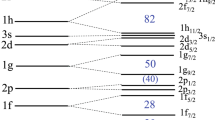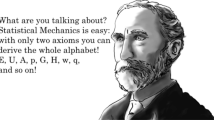Abstract
The shell model of atomic nuclei has been in intensive use since the middle of the previous century. This simple model of very complex nuclei, offers a quantitative description of its many features. Other features follow from small deviations from the extreme picture. Our friend and colleague Akito Arima made seminal contributions to this field starting with his famous paper with Horie on the magnetic moments of nuclei [Prog. Theor. Phys. 11, 509 (1954)]. In the following, a detailed description of a simple example is considered. It is the 1f7/2 shell of the neutrons in the nuclei between 40Ca and 48Ca and of the protons in the nuclei between 48Ca and 56Ni. The results demonstrate the power and elegance of the shell model. They show how simplicity arises out of complexity. It is also shown how small deviations from the simple shell model lead to effects, in which valence neutrons act as if they carry electric charge.
Similar content being viewed by others
References
A. Arima and H. Horie, Configuration mixing and magnetic moments of odd nuclei, Prog. Theor. Phys. 11, 509 (1954)
W. Heisenberg, Ueber den Bau der Atom Kerne, Zeits. F. Physik. 77, 1 (1932)
J. H. Bartlett, Nuclear structure, Nature 130, 165, Structure of atomic nuclei, Phys. Rev. 41, 370 (1932)
W. M. Elsasser, Sur le principe de Pauli dans les noyaux, J. de phys. et radium 4, 549; II 5, 389; III 635 (1934); Energies de liaison des noyaux lourds, 6, 473 (1935)
N. Bohr, Neutron Capture and nuclear Constitution, Nature 137, 344 (1936)
G. Racah, Theory of complex spectra (I), Phys. Rev. 61, 186; Theory of complex spectra (II), Phys. Rev. 62, 438 (1942); Theory of complex spectra (III), Phys. Rev. 63, 367 (1943)
M. G. Mayer, On closed shells in nuclei, Phys. Rev. 74, 235 (1948)
E. Feenberg and K. C. Hammack, Nuclear shell structure, Phys. Rev. 75, 1877 (1949)
L. Nordheim, On spins, moments and shells in nuclei, Phys. Rev. 75, 1894 (1949)
M. G. Mayer, On closed shells in nuclei (II), Phys. Rev. 75, 1969
O. Haxel, J. H. D. Jensen and H. E. Suess, On the “magic numbers” in nuclear structure, Phys. Rev. 75, 1766 (1949), where earlier references are listed.
M. G. Mayer, Nuclear configurations in the spin-orbit coupling model (I): Empirical evidence, Phys. Rev. 78, 16 (1950)
M. G. Mayer, Nuclear configurations in the spin-orbit coupling model (II): Theoretical considerations, Phys. Rev. 78, 22 (1950)
G. Racah, Nuclear coupling and shell model, Phys. Rev. 78, 622 (1950)
D. Kurath, Effect of finite range interactions in the (jj) coupling shell model, Phys. Rev. 80, 98 (1950)
I. Talmi, On the spin of the nuclear ground state in the jj-coupling scheme, Phys. Rev. 82, 101 (1951)
I. Talmi, nuclear spectroscopy with harmonic oscillator wave functions, Helv. Phys. Acta 25, 185 (1952)
K. Ford and C. A. Levinson, Independent-particle model of the nucleus (I): Inter particle forces and configuration mixing, Phys. Rev. 99, 742 (1955); Independent-particle model of The nucleus (III): The calcium isotopes, Phys. Rev. 100, 13 (1955)
S. Goldstein and I. Talmi, Related jj-coupling configurations in 38Cl and 40K, Phys. Rev. 102, 589 (1956)
S. P. Pandya, Nucleon-hole interaction in jj-coupling, Phys. Rev. 103, 956 (1956)
I. Talmi and I. Unna, Theoretical interpretation of energy levels of light nuclei, Ann. Rev. Nucl. Sci. 10, 426 (1961)
R. D. Lawson and J. L. Uretsky, Excited states in the proton f 7/2 shell, Phys. Rev. 106, 1369 (1957)
I. Talmi, Energies of f n 7/2 nuclear configurations, Phys. Rev. 107, 326 (1957)
D. Amit and A. Katz, Effective interaction calculations of energy levels and wave functions in the nuclear 1p shell, Nucl. Phys. 58, 388 (1964)
S. Cohen and D. Kurath, Effective interaction for the 1p shell, Nucl. Phys. 73, 1 (1965)
B. H. Wildenthal, Empirical strengths of spin operators in nuclei, Prog. Part. Nucl. Phys. 11, 5 (1984), where earlier references are listed.
B. A. Brown and B. H. Wildenthal, Status of the nuclear shell model, Ann. Rev. Nucl. Sci. 38, 29 (1988)
E. Caurier, G. Martinez-Pinedo, F. Nowacki, A. Poves, and A. P. Zuker, The shell model as a unified view of nuclear structure, Rev. Mod. Phys. 77, 427 (2005)
T. Otsuka, et al., Monte Carlo shell model for atomic nuclei, Prog. Part. Nucl. Phys. 47, 319 (2001)
N. Shimizu, et al., New-generation Monte Carlo shell model for the K computer era, Prog. Theor. Exp. Phys. 2012, 01A205 (2012)
B. H. Flowers, Studies in jj-coupling (I): Classification of nuclear and atomic states, Proc. Roy. Soc. A 212, 248 (1952)
G. Racah, Nuclear levels and Casimir operator, in: Farkas Memorial Volume, Res. Council of Israel, Jerusalem, 1952
A. de Shalit and I. Talmi, Nuclear Shell Theory, Academic Press, 1963, reprinted by Dover Publications, 2004
I. Talmi, Simple Models of Complex Nuclei, Harwood, 1993
E. P. Wigner, Group Theory and Its Application to the Quantum Mechanics of Atomic Spectra, Academic Press, 1959
G. Racah, Theory of complex spectra (II), Phys. Rev. 62, 438 (1942)
E. P. Wigner, Unpublished widely circulated MS. Reprinted in: Quantum Theory of Angular Momentum, Eds. L. C. Biedenharn and H. van Dam, Academic Press, 1965
I. Talmi, Effective interactions and nuclear models, in: Proc. Int. School Phys. Enrico Fermi, Varenna (1984)
A. Volya. Manifestation of three-body forces in f 7/2-shell nuclei, Europhys. Lett. 86, 52001 (2009)
P. Van Isacker and I. Talmi, Effective three-body interactions in nuclei, Europhys. Lett. 90, 32001 (2010)
R. F. Garcia Ruiz, et al., M. L. Bissell, K. Blaum, Ground-state electromagnetic moments of calcium isotopes, Phys Rev. C 91, 041304(R) (2015)
L. Zamick, Two-body contribution to the effective radius operator, Ann. Phys. 66, 784 (1971)
I. Talmi, On the odd-even effect in the charge radii of isotopes, Nucl. Phys. A 423, 189 (1982)
A. Andl, K. Bekk, S. Göring, et al., Isotope shifts and hyperfine structure of the 4s2 1S0–4s4p1P1 transition in calcium isotopes, Phys. Rev. C 26, 2194 (1982)
A. Arima and F. Iachello, Collective nuclear states as representations of a SU(6) group, Phys. Rev. Lett. 35, 1064 (1975)
E. U. Condon and G. H. Shortley, The Theory of Atomic Spectra, Cambridge University Press, 1951
G. Racah, Model interactions in atomic spectroscopy, J. Quant. Spectroscop. Radiat. Transfer 4, 617 (1964)
I. Talmi, Generalized seniority and structure of semimagic nuclei, Nucl. Phys. A 172, 1 (1971)
Acknowledgements
This paper is dedicated to Akito, on his reaching 88 years as a token of appreciation and friendship.
Author information
Authors and Affiliations
Corresponding author
Rights and permissions
About this article
Cite this article
Talmi, I. The nuclear shell model: Simplicity from complexity. Front. Phys. 13, 132103 (2018). https://doi.org/10.1007/s11467-018-0847-2
Received:
Accepted:
Published:
DOI: https://doi.org/10.1007/s11467-018-0847-2




